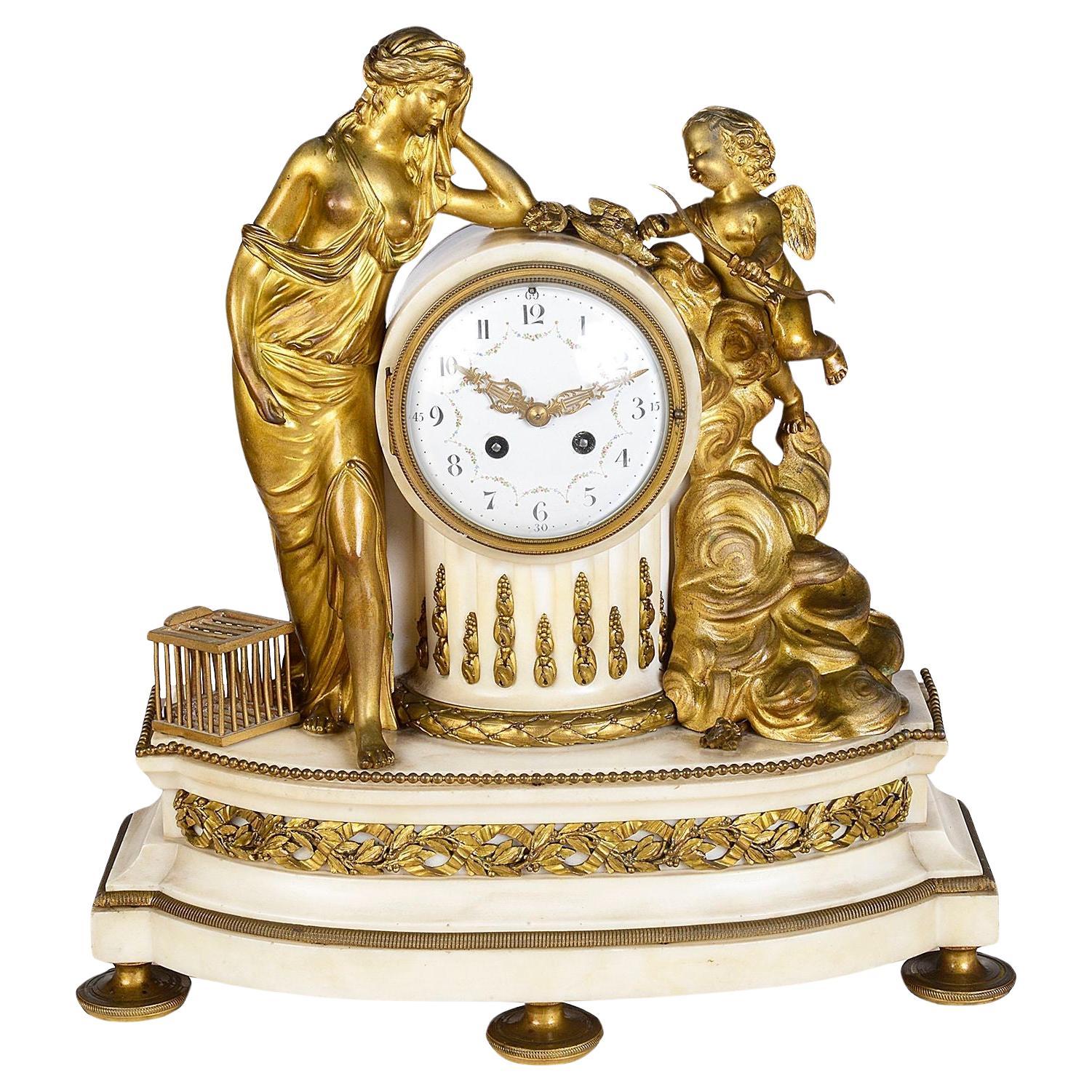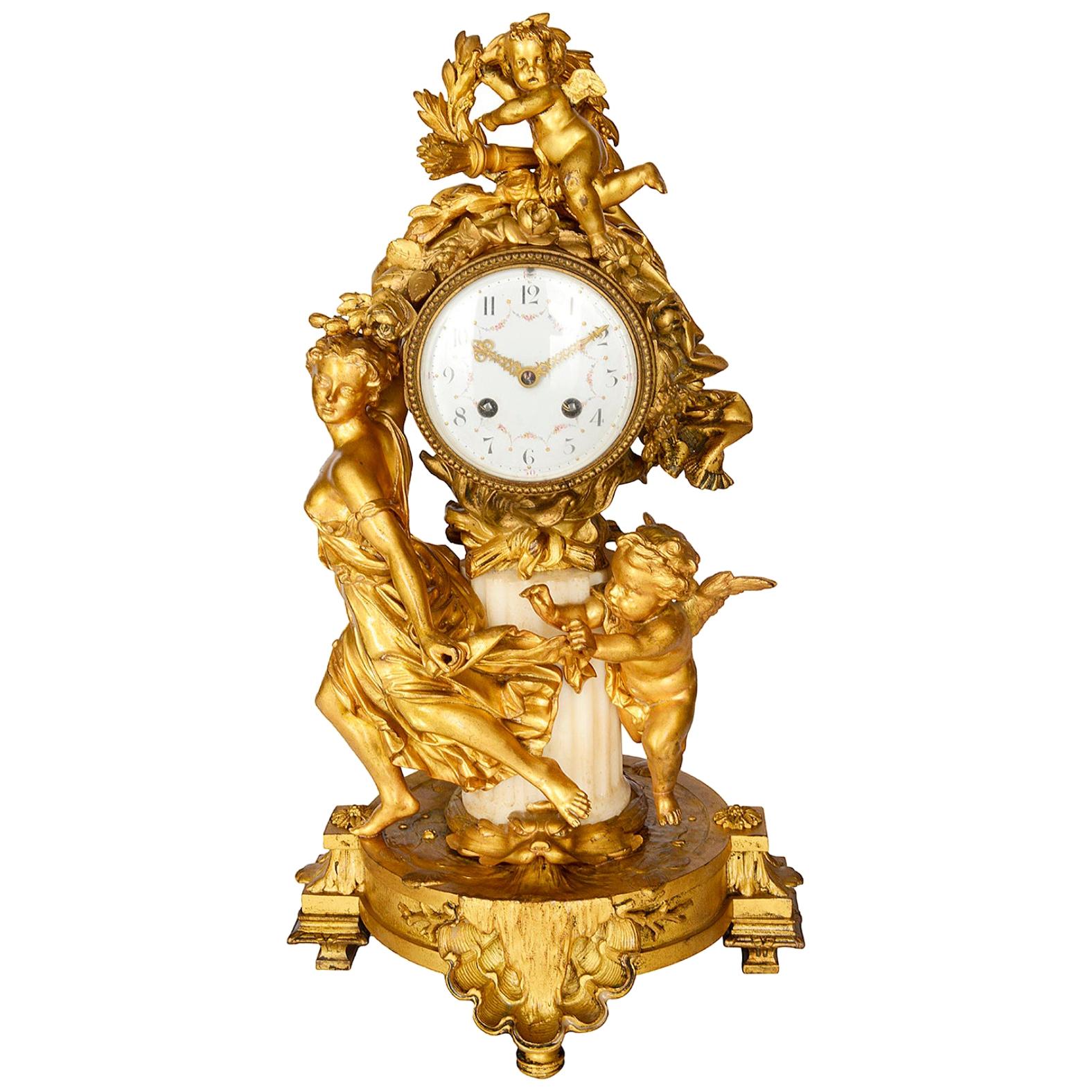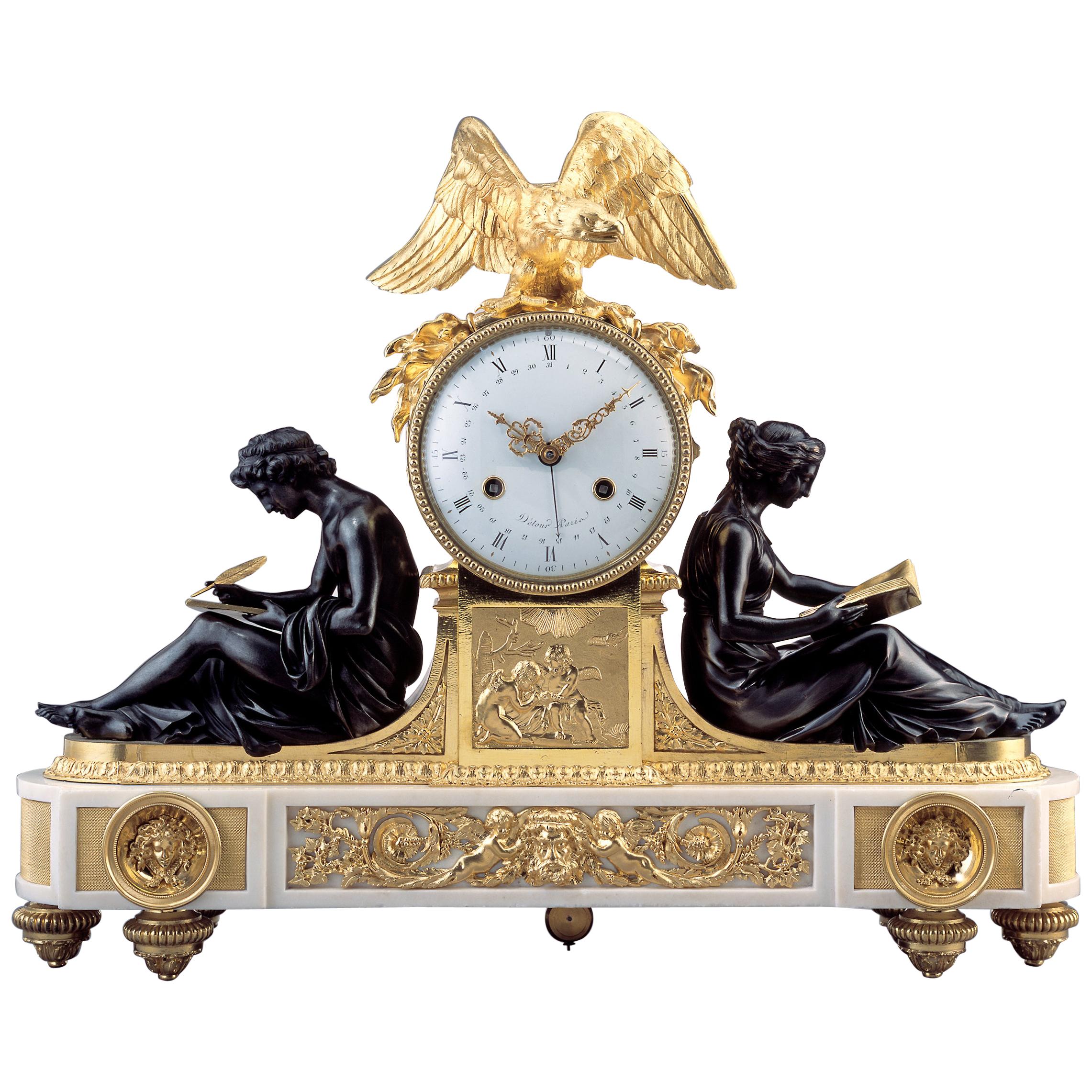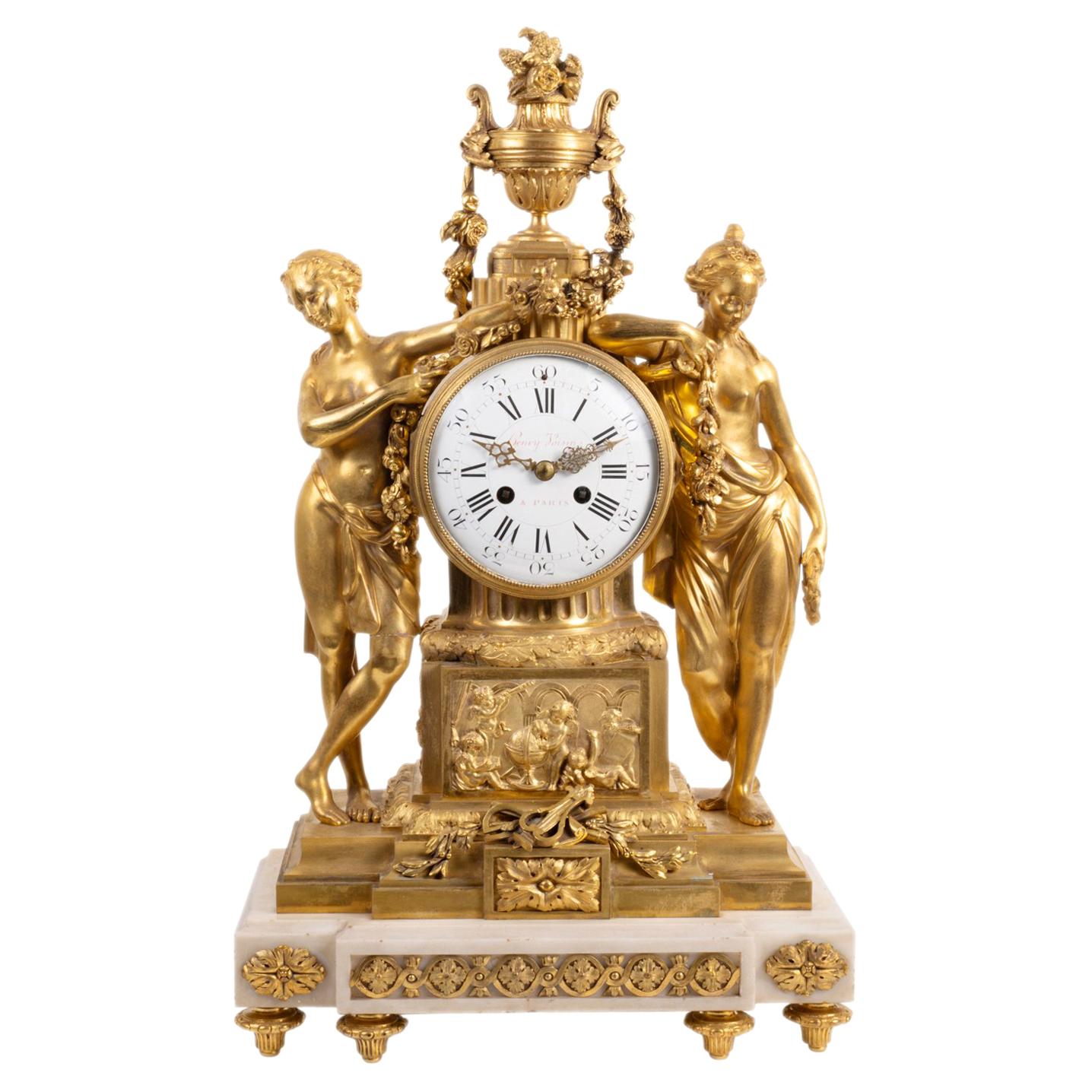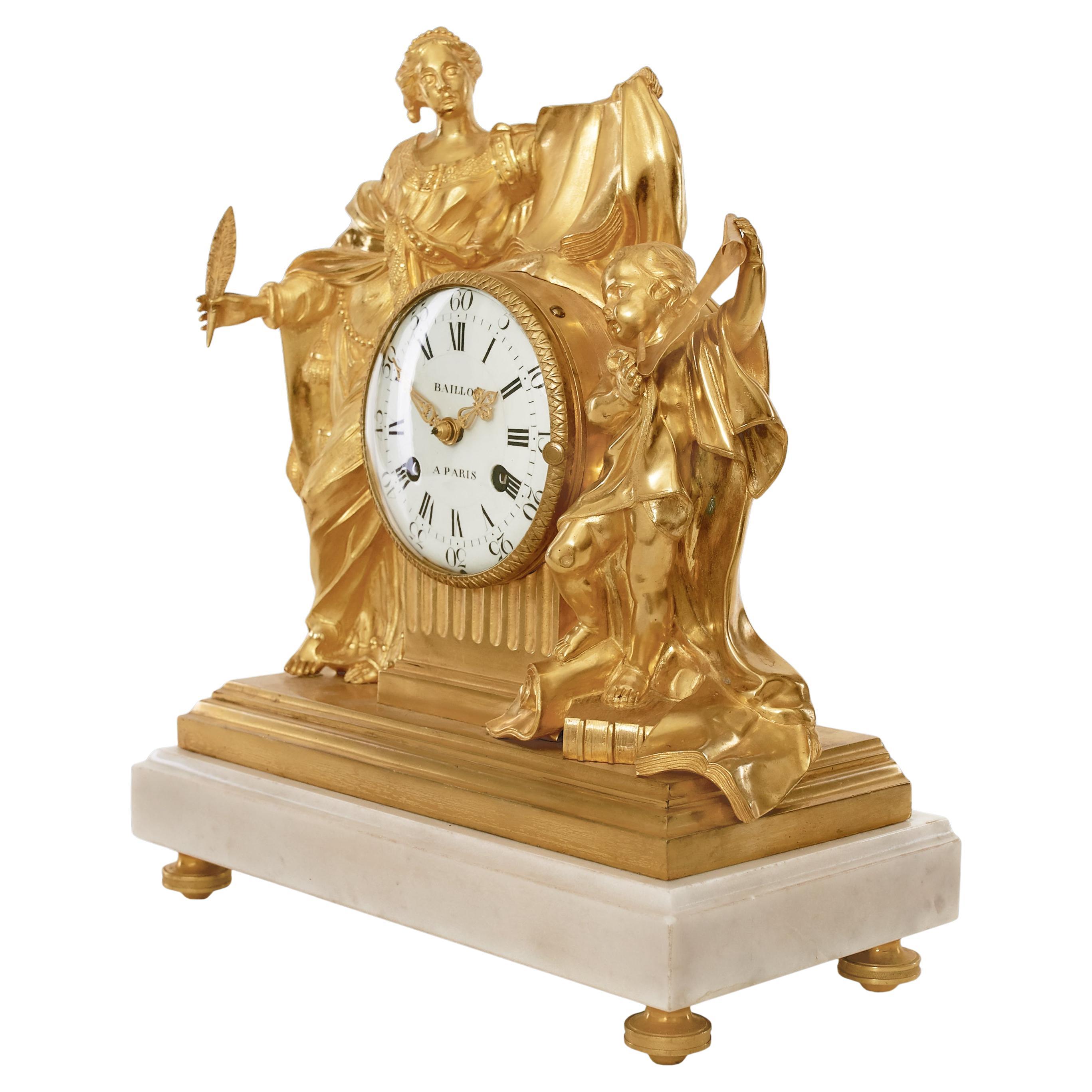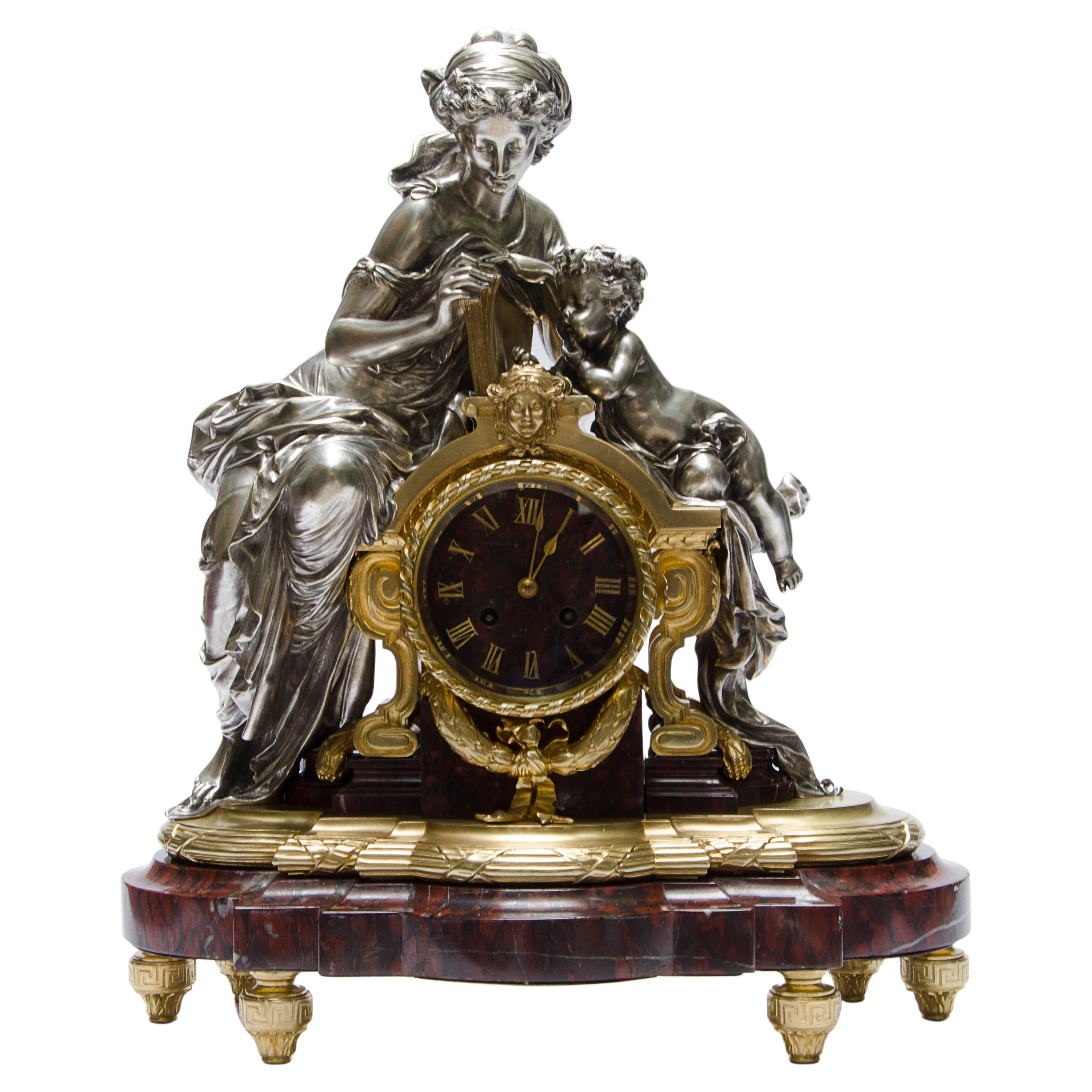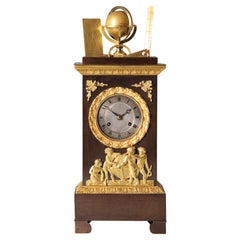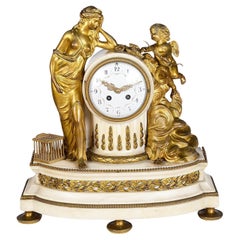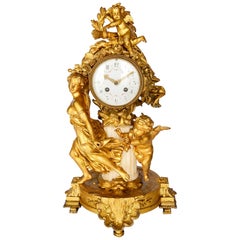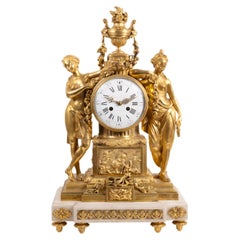Items Similar to 19th Century French Louis XVI Style "Astronomy" Mantel Clock, circa 1845
Video Loading
Want more images or videos?
Request additional images or videos from the seller
1 of 22
19th Century French Louis XVI Style "Astronomy" Mantel Clock, circa 1845
$6,873.69
£5,246.69
€5,850
CA$9,695.68
A$10,650.28
CHF 5,565.90
MX$127,013.37
NOK 70,479.35
SEK 65,657.46
DKK 44,588.24
About the Item
French mantel clock "Astronomy"
Paris
Bronze, marble
Mid 19th century
Dimensions: H x W x D: 38 x 55 x 16 cm
Description:
A Louis XVI-style figural mantel clock mounted on a two-tiered black marble base, made in the mid-19th century.
The theme of the clock, astronomy, is embodied by two studying ladies in antique-style robes. Seated on the steps to the left and right of the clockwork, one measures the celestial globe, the other notes down the studies. The globe is mounted in a celestial meridian, on the holder we see the twelve signs of the zodiac.
The beautiful dial is protected behind domed glass. Unlike most other clocks of the time, the bezel is not fitted with a door hinge, but is opened by turning it as a bayonet catch.
On a white enamel background, we see a finely drawn minute scale and the 5-minute increments in black Arabic numerals. The inner circle is formed by the blue Roman hour numerals.
The dial bears the signature: PERRELET ET FILS - H(orlo)GERS ME(cani)CIENS DU ROI.
The movement is a French pendulum movement with an 8-day power reserve, lock disc striking mechanism with half-hour strike on a bell and thread suspension of the pendulum.
In addition to the engraving "PERRELET ET FILS PARIS", we also find a stamped medal on the back plate of the movement: "DOUILLON A ST NICOLAS / M'TION HONOR'LE".
The Perrelet clockmaking family, originally from Le Locle, Switzerland, had already made a name for itself in Paris in the mid-18th century. The company established in Le Locle sent its sons and potential successors to France for an apprenticeship, where it maintained good relations with the famous Breguet workshop in Paris. Breguet himself originally came from Neuchatel in Switzerland, the same region as the Perrelets.
Some important inventions and innovations are attributed to the Perrelets, such as the first automatic movement at the end of the 18th century, which used the energy generated by the wearer's movement to wind the watch. In the early 19th century, the Perrelets worked on astronomical clocks, among other things, and were awarded the medal of the French Academy of Sciences for one of their patents in 1830. Since medals of this type were usually used to stamp clock movements even years after they were awarded, I assume that the above-mentioned stamp is precisely this medal.
At the time the clock offered here was made, around 1840-50, they were working at the Cour de Rohan in Paris and signed "Horlogers et Mecaniciens du Roi".
The Perrelet company still exists today, producing watches in Switzerland.
Condition:
Authentic, restored condition with age-appropriate rubbing to the patination of the bronze. The gilding is beautifully preserved. The movement has been dismantled, cleaned and overhauled. It runs absolutely reliably.
The signature is itemised in the following clockmaker's directory:
Tardy - Dictionnaire Horlogers Francais p. 509
- Creator:Perrelet (Clockmaker)
- Dimensions:Height: 14.97 in (38 cm)Width: 21.66 in (55 cm)Depth: 6.3 in (16 cm)
- Style:Louis XVI (In the Style Of)
- Materials and Techniques:
- Place of Origin:
- Period:
- Date of Manufacture:1845
- Condition:Wear consistent with age and use. Authentic, restored condition with age-appropriate rubbing to the patination of the bronze. The gilding is beautifully preserved. The movement has been dismantled, cleaned and overhauled. It runs absolutely reliably.
- Seller Location:Greven, DE
- Reference Number:1stDibs: LU5419243202492
About the Seller
5.0
Platinum Seller
Premium sellers with a 4.7+ rating and 24-hour response times
Established in 2014
1stDibs seller since 2020
207 sales on 1stDibs
Typical response time: 1 hour
- ShippingRetrieving quote...Shipping from: Münster, Germany
- Return Policy
More From This Seller
View All19th Century Mantel Clock "Astronomy", France circa 1830
Located in Greven, DE
Antique mantel clock on the theme of astronomy
France
Bronze
Charles X around 1830
Dimensions: H x W x D: 48 x 19 x 10 cm
Description:
Unusual and beautifully crafted bronze mante...
Category
Antique 19th Century French Charles X Table Clocks and Desk Clocks
Materials
Bronze
19th French Empire Mantel Clock, Pendule, Mercury, Gilded Bronze, circa 1815
Located in Greven, DE
19th century French pendule, mantel clock - Mercury the messenger of the gods
France
Bronze gilded
Empire around 1815
Dimensions: H x W x D: 37 x 30 x 10 cm
Description:
French Empire...
Category
Antique Early 19th Century French Empire Mantel Clocks
Materials
Bronze
Early 19th Century French Mantel Clock, signed Ferey au Havre, Ormolu
Located in Greven, DE
Small mantel clock with bas-relief
France
Bronze, enamel
early 19th century
Dimensions: H x W x D: 33 x 19 x 9 cm
Description:
Antique, fire-gilt portal clock with figurative, Gre...
Category
Antique Early 19th Century French Empire Mantel Clocks
Materials
Bronze, Enamel, Ormolu
French Empire Ormulu Bronze Mantel Clock, Lepaute, Thomire, Paris, circa 1815
Located in Greven, DE
Ormulu pendule with depiction of friendship and love
Paris (Lepaute, Thomire)
fire-gilt bronze
Empire around 1815
Dimensions: H x W x D: 44 x 36 x 13 cm
French pendulum movement with eight days duration. Thread suspension and lock disc striking movement with strike on bell on the half and full hour.
White enamel dial with Roman hour numerals and Breguet hands.
Signature: LePaute & Fils / Hrl. du Roi (Pierre-Basile Lepaute (1750 - 1843) with his son Pierre-Michel Lepaute (1785-1849); from 1811 in joint workshop).
Description:
The extremely high quality pendulum shown here takes up a profound theme: Friendship, which combines with love and can thereby outlast time and death. As it is typical for the epoch of classicism, personifications and symbols are taken from the fund of ancient mythology and art and then developed further.
The main figure is a young woman in an antique, girded garment, standing barefoot and with crossed legs next to an altar, on which she is leaning with her left elbow. She gracefully bows her head towards a tempestuously approaching Cupid, grasps his right hand with her left and draws him to her bosom, the seat of the heart. The delicate ambivalence of flying towards and being held culminates in the trustingly intimate look that the two cast at each other.
The young woman personifies friendship, the winged Cupid love. As a sign of their intimate connection, two burning hearts appear on the altar next to the two, framed by the puffed scarf, which are closely bound together by a chain of flowers.
Next to them, on the altar slab, one can see an erected book with the title "Amitie" (French: amitie, friendship). Supporting the book is a pomegranate held by a ring of pomegranate flowers. The bursting seeds spill out of the cracked skin. Since ancient times, the pomegranate and its blossoms have been dedicated to the goddess Persephone, symbolizing the underworld and death, but also life and fertility. The myrtle interwoven in the pomegranate flower wreath of "friendship" also has a far-reaching symbolic power: the plant was dedicated to the goddess Aphrodite, stands for virginity, and was and is therefore obligatory in the bridal wreath...
Category
Antique Early 19th Century French Empire Mantel Clocks
Materials
Bronze, Enamel
Early 19th Century Ormolu Mantel Clock, Atala freeing Chactas, Paris, circa 1810
Located in Greven, DE
Mantel Clock "Atala and Chactas"
Paris
Bronze (fire-gilt and patinated), enamel
Empire around 1810
Dimensions: H x W x D: 40 x 32 x 11 cm
Description:
Very rare and extremely high quality French mantel clock, so-called Pendule Au Bon Sauvage.
Depicted are scenes from the love story "Atala or the love of two savages in the desert" written by Francois René Vicomte de Chateaubriand in 1801. At the beginning of the 19th century, this was probably the most famous love story in Europe, but today it has been forgotten.
The story, set in present-day Louisiana (USA), is roughly rewritten about the forbidden love between Chactas, a young Indian, and Atala, the beautiful daughter of a Spaniard.
Chactas is captured in a battle between two Indian tribes, chained to a palm tree and is to be sacrificed. Atala wants to save his life and convert him to Christianity. She unties him from the palm tree at night and they flee together into the wilderness of North America. Their love for each other grows stronger and stronger and they have prospects for a future together.
The story takes a tragic turn when Atala, who must remain a virgin due to a vow made by her mother, can no longer withstand the conflict of her feelings and commits suicide.
The main group of characters thus shows Chacta's liberation through Atala. Atala is leaning against a pile of logs. The animal fur thrown over the logs and the weapons leaning against the stack on the right give the impression of a night camp.
The bronze is of rarely beautiful quality, finely chiselled and makes the scene appear very lively. The contrast of fire-gilded and patinated bronze adds tension to the composition.
In the base we see the Entombment as the end of the tragic love story. This bronze work is also very detailed, the interplay of bright and matt gilding makes the flat relief appear much deeper than it is.
The depiction of the mantel clock presented here shows that the exotic was only known from stories and that the bronzier had his own ideas about the appearance of this distant world. The Indian, for example, has very European facial features and his skin was not black in reality, of course. The palm tree was also certainly not found in the North American wilderness.
The heart of the clock is a French pendulum movement, integrated into the wooden pile, with an eight-day power reserve and a lock plate striking a bell on the half and full hour. The pendulum is suspended on a thread, typical of the period. The classically shaped hands, so-called Breguet hands, are also typical of the time.
The enamelled dial has black Roman hour numerals, Arabic quarter hours and bears the signature: Le Roy hr. de Madame A PARIS.
Interesting facts:
The period from 1795 to about 1815 saw the creation of probably the most spectacular group of bronzes: The "Au bon Sauvage" pendulums - depictions of the "Noble Savage".
Today's viewers react to these objects with both fascination and irritation. Enthusiastic on the one hand about the obvious quality of the detailed bronzes and the allure of the exotic, on the other hand distanced and cautious because of the possible discrimination that is suspected behind them. The ambivalence of this feeling motivates the search for the conditions of origin of these pendulums.
Europeans found their new ideal of the natural man primarily in fictional and realistic travelogues about the Indians of North America...
Category
Antique Early 19th Century French Empire Mantel Clocks
Materials
Ormolu
Late 19th Century French Black Marble Mantel Clock
Located in Greven, DE
French Mantel Clock
Paris, circa 1870
Black marble with gilt bronze mounts
Dimensions: H × W × D: 41 x 23 x 12 cm
Description:
Case in black marble with richly chased and gilt bro...
Category
Antique Late 19th Century French Napoleon III Table Clocks and Desk Clocks
Materials
Marble, Bronze, Enamel
You May Also Like
French Louis XVI style mantel clock, 19th Century
Located in Brighton, Sussex
A good quality French gilded ormolu and white marble, 19th Century Louis XVI style mantel clock, with a classical maiden resting, a bird cage at her feet, a cherub holding a bow and ...
Category
Antique 19th Century French Mantel Clocks
Materials
Marble, Ormolu
French 19th Century Louis XVI Style Mantel Clock
Located in Brighton, Sussex
An enchanting late 19th century French gilded ormolu and marble mantel clock, depicting cherubs playing, one chasing a young girl, the other hiding amongst a wreath and foliage. The ...
Category
Antique Late 19th Century French Louis XVI Mantel Clocks
Materials
Marble, Ormolu
Rare Late 18th Century Neoclassical Louis XVI Ormolu Mantel Clock
Located in Worpswede / Bremen, DE
The circular white-enameled dial signed ”Detour Paris” with Roman hours and Arabic quarter marks, a further inner Arabic chapter ring for the day of month. Pierced gilt hands and a b...
Category
Antique Late 18th Century French Neoclassical Mantel Clocks
Materials
Marble, Bronze, Enamel
Large Louis XVI Style Ormolu Mantel Clock, 19th Century
By Henri Voisin
Located in Brighton, Sussex
A Fine quality French 19th century gilded ormolu and white marble mantel clock in the Louis XVI style. Having a two handled urn to the top with flowers and garlands draping down to t...
Category
Antique Early 19th Century French Louis XVI Mantel Clocks
Materials
Marble, Ormolu
$9,086 Sale Price
20% Off
Mantel Clock 18th Century Louis XVI Period by Baillon À Paris
Located in Warsaw, PL
This exceptional mantel clock was crafted by Jean-Baptiste Baillon III, one of the most renowned and innovative horologists of his era. Baillon served an elite clientele, including t...
Category
Antique 18th Century French Louis XVI Mantel Clocks
Materials
Marble, Bronze
$5,498 Sale Price
28% Off
19th Century French Louis XVI Ormolu Mantel Clock by Lemerle-Charpentier & Cie.
By Lemerle-Charpentier & Cie
Located in North Miami, FL
Late 19th century french Louis XVI ormolu gilt bronze mantel clock by Lemerle-Charpentier & Cie.
By: Lemerle-Charpentier & Cie.
Materi...
Category
Antique Late 19th Century French Louis XVI Mantel Clocks
Materials
Marble, Ormolu, Metal, Bronze
More Ways To Browse
Breguet Antique
Antique Bayonets
Antique French Medals
Celestial Globe
Antique Celestial Globe
Astronomical Clock
Le Locle
8 Day Power Reserve
Brass Clock Set
Antique Copper Rings
Bird Clock
Ormolu Figural Clock
Signed French Urn With Cherubs
Antique Arts And Crafts Clock
French Portico Clock
Antique English Mantel Clock
Clocks with Pendulums
Lyre Clock
